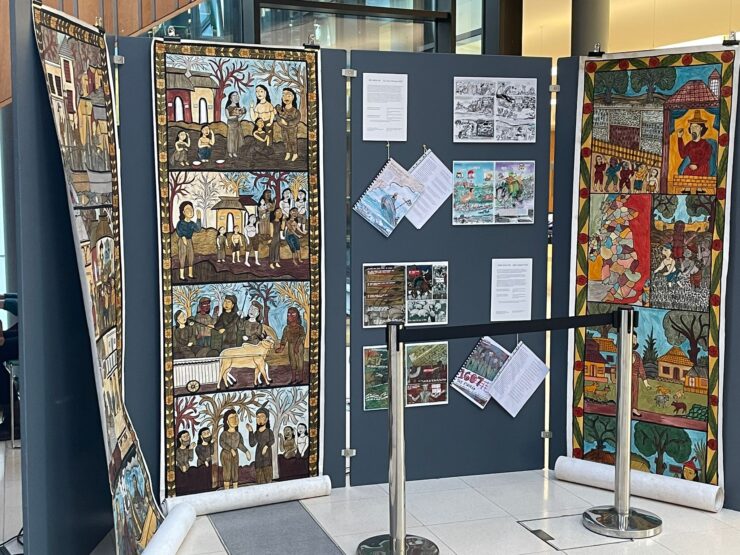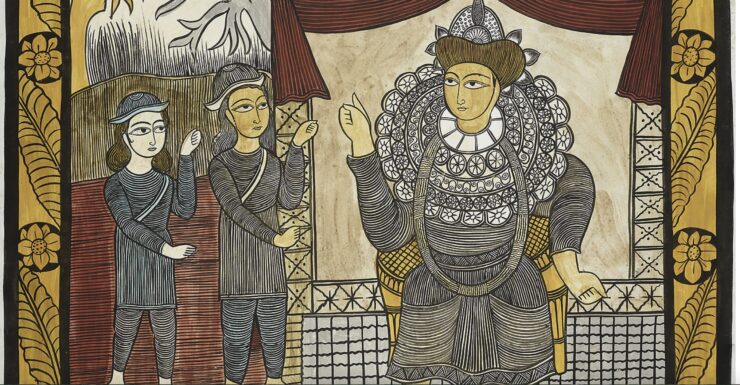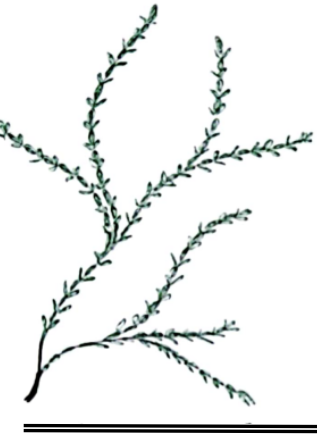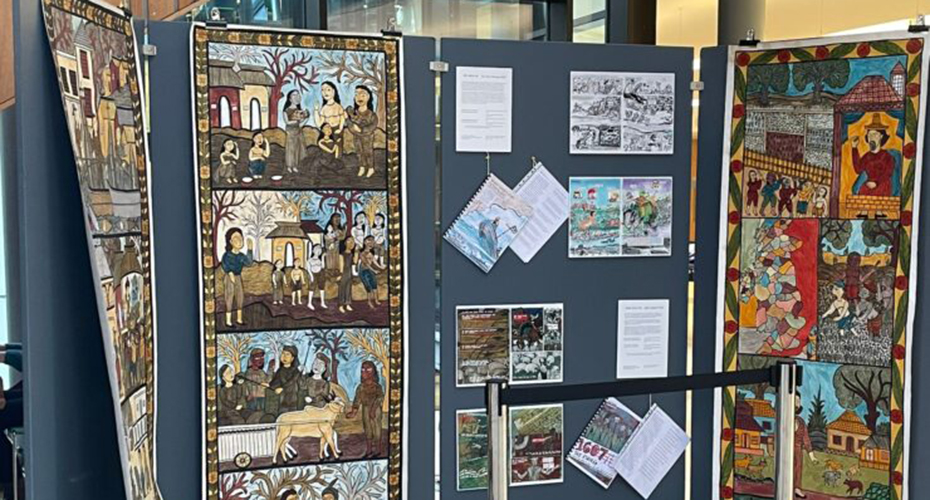By Shreya Gupta and Shibani Das, PhD Candidates in History
Thousands of students walk through the Forum every day, rushing to class, the library or stumbling out of the RAM bar. One witnesses a pause in this bustle at the queue winding its way to grab a coffee at PRET.
Between the 9th to the 11th of November, students at the University of Exeter found another reason to pause in the Forum: An exhibition recounting stories of famine through poetry, scroll paintings and graphic art, titled Durbhikkha Katha (‘Famine Tales from India and Britain’), part of an AHRC-funded project organised by the University of Exeter in collaboration with Jadavpur University and the British Library.

This exhibition used a variety of visual sources to highlight contemporaneous stories of famine and dearth in early modern India and Britain. It depicted famine stories through scroll paintings by Patachitrakars, traditional scroll painters and singers of Naya village in West Bengal as well as by urban graphic artists from urban Kolkata (Calcutta). The exhibition is part of the outreach initiative of the project “Famine and Dearth in India and Britain, 1550-1800”, directed by Prof. Ayesha Mukherjee, Department of English, Exeter. Part of the project’s aim is to speak to the importance of understanding the heritage of famine through a cross-cultural lens. By its poignant portrayal of the suffering from starvation, the exhibition reminded the viewer to be aware of contemporary realities of communities struggling with issues of food security, hunger, and poverty.
In its themes, the exhibition traversed both geographic and cultural spaces. It did the former by narrating local Indian interpretations of the famines in England. We see that both Britain and India were experiencing tough conditions of famine at the same time. The experience this generated is contrasted cleverly in the exhibition. The Patachitrakars, for instance, narrativize the famine in England by telling the story of “Shekkhopir” – an interesting Bengali rendition of “Shakespeare”, who wrote many of his plays during these dire days. This Bengali version also reminded the viewer of the way iconography permeates across borders. Queen Elizabeth I is recognisable, for instance, from the white ruffs and pearls covering her neck in the scroll painting of Shekkhopir-deshe Durbhikkho (‘Famine in Shakespeare-land’).

The Bengal Famine of 1770 (Chhiattor-er-Monnontor) was documented by William Hunter. Peter Mundy (a fisherman and pilchard merchant from Penryn who was in Gujarat during the famine in the 1630s) provided a second account from his memories of the Gujarat famine of 1630. Both the famines were depicted not only in composition but even in the colour palette. The browns, pale yellows and whites betrayed the absence of life and livelihood in periods of drought. Red and yellow are used for the palaces of the Mughals and show their abundance at a time when people suffered from a lack of subsistence. Interestingly, indicators of social hierarchy and differentiation remained despite the all-encompassing dearth. Maybe this discomfort was intended. The empty bowls, vacant farmlands drain out the colour from the lives of the local settlements, taxes were increased but the spirit of the people was yet to be broken. The Durga Puja celebrations stand witness to the same.
Another interesting juxtaposition in this exhibition is of different mediums. Placing poetry, like the tale of Peter Mundy with a comic/digital art version as well as traditional scroll paintings gave plenty of food for thought. It helps explore how artists present multiple renditions of comparable stories. For all these stories, the poem is supposed to be sung as the scroll is revealed and must make for an interesting multisensorial experience. Hearing the harmony of voices singing a poem inspired by the Midlands Revolt of 1607, a tale about collective protest must have made the audience think about the power of solidarity. In the exhibition, together the caricaturised but crude lines of animals eating starved bodies in the paintings, the glossy depictions in the comic book and the witty rhyme of the poem speaks to the massive impact the two famines must have had in their time.
While these famines occurred in the early modern period, the artists who have drawn their work based on these stories continue to face problems of hunger in the present day. The artists have taken archival sources, texts, and travel accounts from the pre-colonial period as their inspiration to draw and narrate these famine tales. This bridging of temporal space only reinforces the relevance of such tales across time. By showcasing art from communities that face similar problems related to food security, the exhibition reminds us of the urgent need to address these issues, especially today when climate change accelerates at a rapid speed.

